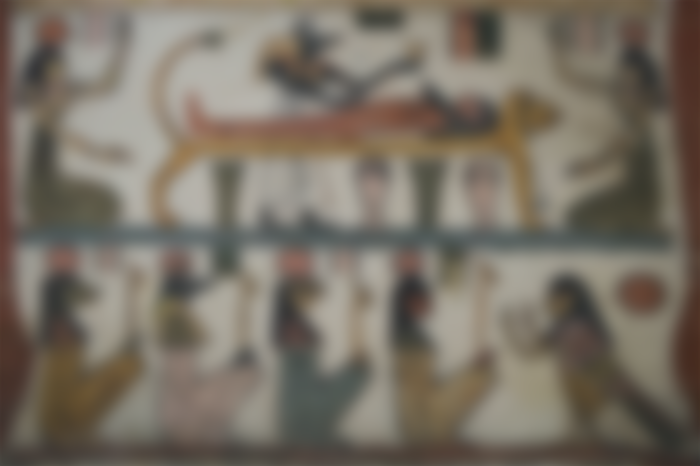Ancient Egypt-Mummification
Ancient Egypt-Mummification
After the mummification process, which was initially applied only to the Pharaohs, it began to be applied to the nobles and commoners as well. There are mummification styles in almost every civilization. However, it was undoubtedly the Egyptian civilization that best practiced mummification in ancient times. Ancient Egypt was full of mummification examples. Even domestic animals such as cats and dogs were mummified. The reason for mummification was to remain the same as the appearance in the world at the beginning of the afterlife according to religious rules. Even people without arms were fitted with prostheses and the appearance was completed. Because he shouldn't have a missing limb in his other life. People who died also wanted their pets with them after they died. Cat and dog mummies are also frequently encountered in research on ancient Egypt. So what is used in mummification? How do mummies not spoil? Which organ is discarded during mummification? We have listed everything you wonder about mummification techniques for you.
Scientists also examined the mummy of Nesyamun, a priest during the reign of Ramses XI, and managed to make the mummy speak with artificial vocal cords. If you want to have detailed information about the sound obtained from a 3,000-year-old mummy, you can take a look at our content, "Scientists Who Can Hear the Sound of a 3,000-Year-Old Mummy".
What is mummification?

The process of embalming, or preserving the dead, was once a common practice in ancient societies. Although horror movies and gothic books are the first thing that comes to mind when mummification is mentioned today, the future of mummification had a very important place in ancient times. Mummies are also seen as symbols that evoke death for people. For this reason, mummies have been the subject of horror movies, religious traditions and novels over the years and have managed to attract the attention of the public. The mummification process, which was effective in ancient times, was carried out by knowledgeable people and was considered a very honorable tradition. It was applied as a means of blessing the deceased or to express a valuable religious belief, especially the belief in the afterlife. It is known that various cultures and beliefs in history mummified their dead. The best-known civilization was recorded as the Ancient Egyptians, but mummification was preferred and used by the majority of pre-Columbian Southern societies, including the Chinese, the ancient people of the Canary Islands, the Guanche, and the Incas.
How is mummification done?
We talked about the mummification process. So how is mummification done? Let's answer right away. Mummification is the process of preserving the body as it is after death by consciously drying the body or spraying it so that the physical body does not deteriorate. In general terms, this process takes place by drawing moisture from the body of the deceased and using resin-like chemicals or natural preservatives to dry the skin and organs. Mummies can also form through unintended or accidental processes called "natural" mummification. Natural mummification can also occur when the body of the deceased is exposed to cold and dry conditions or another environmental cause that slows down the decay process.
The oldest mummy in North America, found in Spirit Cave outside of Fallon, Nevada, is a natural mummy specimen. The mummy specimen, which was found in a deep tomb wrapped in straw, is preserved for years without deteriorating its appearance due to the dry air and low oxygen content of the cave. The body, discovered in 1940 and thought to be 2,000 years old, was actually more than 10,000 years old when radio-carbon dated in the 1990s. On the other hand, the oldest known naturally preserved Egyptian mummy dates back 5,500 years. It is estimated that the mummy belonged to a young woman whose body was wrapped in linen and fur after she died. Another mummy preserved by natural methods is also the oldest known mummy in Europe. After Ötzi the Iceman, who lived about 5,300 years ago, was killed on the spot in the present-day Italian Alps, his body was preserved intact in snow and ice until his remains were discovered by tourists who came to the area in 1991.
What are mummification techniques?

1. Black Mummies
It is at the top of our list of "Black Mummies", first published in the Latin American Antiquity magazine in 1995. The Chinchorros, a fishing people who lived on the coasts of Chile and Peru about 9,000 years ago, deliberately applied a different embalming technique to their dead. Chinchorros cut off the head, arms, and legs of their dead and cut off their internal organs. They made a hole in the skull of the deceased and removed the brain inside. In order to allow the body to dry in this state, they filled the body with coal. Then they peeled off all the skin. They completely covered the whole body with white ashes, they completed it with sticks they made from tree branches, and they finished the process using the hairs they took from animals. They painted the corpses of their dead with black manganese last and added a handful of black hair on their heads. Because of the use of black manganese, scientists named this mummy model "Black Mummies". Moreover, this frightening practice still continues in some villages.
2. Mummies of Buddhist Priests
Now we will talk about an interesting mummification technique. A technique where a living person dies of his own accord and buddhist monks carry out the mummification process. These people consume food consisting of plant seeds, namely roots, for 3 years with the idea of their bodies reaching nirvana as a result of their decision. In this way, there would be no fat left in the body and the mummification process would have started. People who applied this technique would get rid of body water by drinking poisoned tea and then vomiting so that bacteria would not rot their corpses after death. In addition, the poison in the blood destroyed the bacteria that rotted the physical body after death. So how is this mummification done? Let's explain right away. A priest who is fed as we have described, shuts himself up in a cave or a stone chamber and retreats into seclusion. The priest, who remains motionless, breathes through the pipe in his mouth. The priest holds a rope and on the other end of the rope a rattle located outside the cave. Those outside waiting for the secluded priest will find that if the bell does not shake, he is dead. When the priest dies, it is not moved and is left in the same place. There are 24 mummies found in this way from the 12th century until today. One such mummification was recently found in the interior of a Buddha statue in China in 2015.
3. Mummies from Papua New Guinea
In 1907, British explorer Charles Higgins recorded in writing the mummification of the dead by indigenous people when he went to Papua New Guinea. The deceased is fixed by sitting on a handcrafted chair. This person's internal organs are left in a smoked room, out of the sun, until they dry out. In order not to separate the dried pieces from each other, the pieces are covered with red clay. The mummy was then kept in temples built by the Papua New Guinean native. The mummies, which were taken from their places on special days, were carried around the villages with primitive methods. The relatives of the deceased talked and consulted with their ancestors about the issues that were on their minds and for which they were curious about the answer. Moreover, it is known that this practice still continues in some villages.
4. Swamp Mummies
The mummies found in the marshlands of Ireland are the best preserved mummies ever preserved, perfectly preserved. Some of the mummies have their throats cut, and some have a string around their necks. This supports the notion that the preserved mummies were those who were executed. It is thought that the reason why the corpses are so well preserved is the very low oxygen in the swamps and the inability of bacteria to contact the corpses.
5. Egyptian Mummies
We can say that Egyptian mummies, which have been the subject of countless movies, are the type of mummies that everyone has heard of and knows the most. This mummification style was generally made for Pharaohs and noble family members. The deceased was mummified and placed in a sarcophagus or coffin. In Egypt, where souls were believed to live after death, the deceased soul would be lost if it could not find a body, so the bodies of the dead had to be mummified after death.



